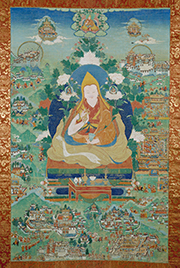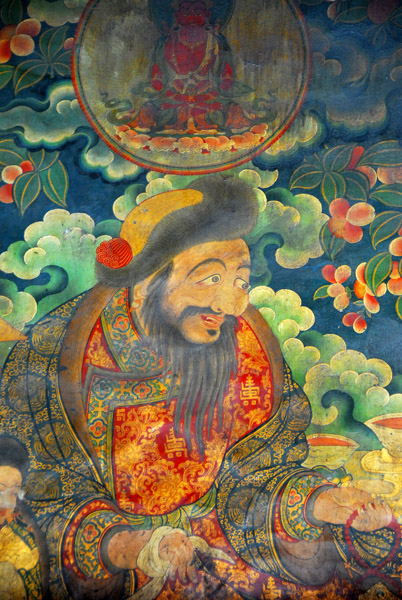The Fifth Dalai Lama and his Reunification of Tibet
Samten G. Karmay
At the time of the Fifth Dalai Lama’s birth, Tibet was in a state of religious, social and political turmoil. Political power was shared among various factions supported by different religious schools who not only wished to propagate their teachings, but also to establish their economic power and political influence. In Tibet, religious, political and economic power have always been closely entwined. Tibetan political theory is based on the coalition of politics and religion in the form of Lamaism, finding its expression in chöyön, a “preceptor-patron” relationship in which both parties are considered equal – the preceptor giving the patron religious teachings and spiritual guidance in return for material and political protection. In addition, political protection allowed the religious schools to increase the number of their disciples and hence their wealth. The term chöyön was often used to designate, in particular, the relationship between a Tibetan lama and the leader of a foreign country, such as that between Phagpa Lodrö Gyeltsen (1235–1280), the head of the Sakya school, and Khubilai Khan, the Mongol emperor, in the 13th century. An understanding of the interdependence of politics and religion is essential for the study of Tibetan history.
The circumstances and strife surrounding the Fifth Dalai Lama’s birth are important to recall in order to understand the decisive role this exceptional man played in the reunification of Tibet.

- The Dalai Lamas – About
- The Dalai Lama in Global Perspective
- 5th Dalai Lama, Ngawang Lobsang Gyatso — About
- 5th Dalai Lama, Ngawang Lobsang Gyatso — Opinion on His Rule
- 13th Dalai Lama, Thubten Gyatso – About
- 13th Dalai Lama, Thubten Gyatso – Opinion on His Rule
- 14th Dalai Lama – About
- 14th Dalai Lama – His Accomplishments
- HHDL
The XIVth Dalai Lama, Tenzin Gyatso.
© www.dalailama.com - printable4_fs
The XIVth Dalai Lama, Tenzin Gyatso.
© www.dalailama.com - printable1_fs
The XIVth Dalai Lama, Tenzin Gyatso.
© www.dalailama.com - printable9_fs
The XIVth Dalai Lama, Tenzin Gyatso.
© www.dalailama.com - printable6_fs
The XIVth Dalai Lama, Tenzin Gyatso.
© Tenzin Jamphel / OHHDL. Details: Official Dalai Lama Facebook Site - printable8_fs
The XIVth Dalai Lama, Tenzin Gyatso.
© www.dalailama.com - printable7_fs
The XIVth Dalai Lama, Tenzin Gyatso.
© www.dalailama.com
The Dalai Lamas
“The Dalai Lamas are held by their followers to be advanced Mahayana bodhisattvas that is compassionate beings who so to speak have postponed their own entry into nirvana to help suffering humanity. Thus they are thought to be well on the way to Buddhahood, developing perfection in wisdom and compassion for the benefit of all sentient beings. It is this that justifies doctrinally the socio-political involvement of the Dalai Lamas, as an expression of a bodhisattva’s compassionate wish to help others.”
“We should note here two things a Dalai Lama is not. First, he is not in any simple sense a ‘god-king’. He may be a sort of king, but he is not for Buddhism a god. Second, the Dalai Lama is not the ‘head of Tibetan Buddhism’, let alone of Buddhism as a whole. There are many traditions of Buddhism. Some have nominated ‘Heads’; some do not. Within Tibet too there are a number of traditions. The Head of the Geluk tradtion is whoever is abbot of Ganden monastery, in succession to Tsong kha pa, the fourteenth/fifteenth century Geluk founder.”
Paul Williams, “Dalai Lama”, in Clarke, P. B., Encyclopedia of New Religious Movements, (New York: Routledge, 2006), p. 136.
The Dalai Lama in Global Perspective
“Westerners who study the system of reincarnating lamas are often understandably skeptical about it, but it seems clear that somehow the Tibetans who choose the Dalai Lamas have managed to find a remarkable succession of unusually gifted people. Even given the profound devotion that Tibetans feel for their Dalai Lamas, it would be difficult to disguise an incarnation who was stupid, arrogant, greedy, or belligerent. Those Dalai Lamas who attained maturity, however, have consistently distinguished themselves in their teaching, writing, and their personal examples. The present Dalai Lama is a testament to the success of the system through which Dalai Lamas are found, and it is improbable that his remarkable Accomplishments are merely due to good training. Many monks follow the same basic training as the Dalai Lamas, but somehow the Dalai Lamas tend to rise above others of their generation in terms of scholarship, personal meditative attainments, and teaching abilities. It is true that they receive the best training, and they also have the finest teachers, but these facts alone fail to account for their accomplishments. In Western countries, many students enroll in the finest colleges, study with the best teachers, and still fail to rise above mediocrity because they are lacking in intellectual gifts.”
“There are obviously problems with the system, particularly the problem of lapses of leadership while newly recognized Dalai Lamas reach maturity. The system worked well enough in the past when Tibet was not beset by hostile neighbors, but it is difficult to imagine any country in the present age being able to endure periods of eighteen years or more without a true leader. It is not surprising, therefore, that the present Dalai Lama has expressed doubts about the continuing viability of the institution of the Dalai Lamas and has indicated that he may not choose to reincarnate. He has also proposed that the office of Dalai Lama become an elected position, with the Tibetan people voting for their spiritual leader. The Dalai Lama appears to recognize the flaws in the present system and apparently hopes that the institution will be adapted to changing times.”
John Powers, “Introduction to Tibetan Buddhism”, Snow Lion Publications, 1995, pp. 186–87.
The Fifth Dalai Lama, Ngawang Lobsang Gyatso (1617–1682)
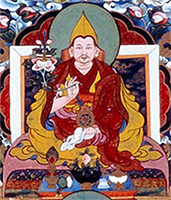
“The 5th Dalai Lama, known to Tibetan history simply as the ‘Great Fifth,’ is renowned as the leader under whom Tibet was unified in 1642 in the wake of bitter civil war. The era of the 5th Dalai Lama—roughly the period from his enthronement as leader of Tibet in 1642 to the dawn of the 18th century, when his government began to lose control—was the formative moment in the creation of a Tibetan national identity, an identity centered in large part upon the Dalai Lama, the Potala Palace of the Dalai Lamas, and the holy temples of Lhasa. During this era the Dalai Lama was transformed from an ordinary incarnation among the many associated with particular Buddhist schools into the protector of the country. In 1646 one writer could say that, due to the good works of the 5th Dalai Lama, the whole of Tibet was now centered under a white parasol of benevolent protection. And in 1698 another writer could say that the Dalai Lama’s government serves Tibet just as a bodhisattva—that saintly hero of Mahayana Buddhism—serves all of humanity.”
Kurtis R. Schaeffer, “The Fifth Dalai Lama Ngawang Lopsang Gyatso”, in The Dalai Lamas: A Visual History, Serinda Publications, Edited by Martin Brauen, 2005, p. 65.
The Fifth Dalai Lama: Opinion on His Rule
“By most accounts the [5th] Dalai Lama was by the standards of his age a reasonably tolerant and benevolent ruler.”
Paul Williams, “Dalai Lama”, in (Clarke, 2006, p. 136).
“The fifth Dalai Lama, Ngawang Losang Gyatso (1617–1682), popularly referred to as ‘The Great Fifth,’ was the most dynamic and influential of the early Dalai Lamas. He was a great teacher, an accomplished tantric yogin, and a prodigious writer. His literary output surpasses the combined total of all the other Dalai Lamas. In addition to his scholastic achievements, he proved to be an able statesman, and he united the three provinces of Tibet (the Central, South, and West) for the first time since the assassination of king Lang Darma in the mid-ninth century.”
“Although he was rather heavy-handed with the Jonangpas and the Karmapas, his treatment of other orders was often generous. He was particularly supportive of Nyingma, and he himself was an ardent practitioner of several Nyingma tantric lineages. Snellgrove and Richardson contend that on the whole his actions proved to be beneficial and stabilizing, despite the obvious hard feelings they engendered among his opponents:
‘The older orders may preserve some bitter memories of the fifth Dalai Lama, for no one likes a diminution of wealth and power, but there is no doubt that without his moderating and controlling hand, their lot might have been very much worse. It must also be said that at that time, despite their new political interests and responsibilities, the dGe-lugs-pas remained the freshest and most zealous of the Tibetan religious orders.’” (Snellgrove & Richardson, A Cultural History of Tibet, p. 197)
(Powers 1995: 145,146–47)
More about the Fifth Dalai Lama
- “The Fifth Dalai Lama and his Reunification of Tibet” by Samten G. Karmay
- “The Great Fifth” by Samten G. Karmay
The Thirteenth Dalai Lama, Thubten Gyatso (1876–1933)
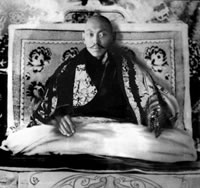
“The other Dalai Lama who was particularly important was the Thirteenth (1876–1933). A strong ruler he tried, generally unsuccessfully, to modernize Tibet. The ‘Great Thirteenth’ also took advantage of weakening Chinese influence in the wake of the 1911 imperial collapse to reassert de facto what Tibetans have always considered to be truly the case, the complete independence of Tibet as a nation from China.”
Paul Williams, “Dalai Lama” in (Clarke, 2006, p. 137).
“Some may ask how the Dalai Lama’s rule compared with that of rulers in European or American countries. But such a comparison would not be fair, unless applied to the Europe of several hundred years ago, when it was still in the same stage of feudal development that Tibet is in at the present day. Certain it is that Tibetans would not be happy if they were governed as people are in England; and it is probable that they are on the whole happier than are people in Europe or America under their own governments. Great changes will come in time; but unless they come slowly, when the people are ready to assimilate them, they will cause great unhappiness. Meanwhile, the general administration in Tibet is more orderly than the administration in China; the Tibetan standard of living is higher than the standard in China or India; and the status of women in Tibet is higher than their status in either of those two large countries.”
Sir Charles Bell, “Portrait of a Dalai Lama: The Life and Times of the Great Thirteenth”, Wisdom Publications, 1987, pp. 443–444.
The Thirteenth Dalai Lama: Opinion on His Rule
“Was the Dalai Lama on the whole a good ruler? We may safely say that he was, on the spiritual as well as the secular side. As for the former, he had studied the complicated structure of Tibetan Buddhism with exceptional energy when a boy, and had become exceptionally learned in it. He improved the standard of the monks, made them keep up their studies, checked greed, laziness and bribery among them, and diminished their interference in politics. He took care of the innumerable religious buildings as far as possible. On the whole it must certainly be said that he increased the spirituality of Tibetan Buddhism.
“On the secular side he improved law and order, increased his own contact with his people, introduced more merciful standards into the administration of justice and, as stated above, lessened monastic domination in secular affairs. In the hope of preventing Chinese invasions he built up an army in the face of opposition from the monasteries; prior to his rule there was practically no army at all. In view of the extreme stringency of Tibetan finance, the intense monastic opposition and other difficulties, he could have gone no farther than he did.
“During his reign the Dalai Lama abolished Chinese domination entirely throughout the large part of Tibet governed by him, excluding Chinese officials and soldiers. That portion of Tibet became a completely independent kingdom, and remained independent during the last twenty years of his life.”
Sir Charles Bell in (Bell 1987: 444).
More about the Thirteenth Dalai Lama
- “The Thirteenth Dalai Lama, Tubten Gyatso” by Tsering Shakya
The Fourteenth Dalai Lama, Tenzin Gyatso
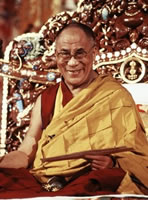
“The current Fourteenth Dalai Lama (Tenzin Gyatso) was born in 1935. The Chinese invaded Tibet in the early 1950s and the Dalai Lama left Tibet in 1959. He now lives as a refugee in Dharamsala, North India, where he presides over the Tibetan Government in Exile. A learned and charismatic figure, he has been active in promoting the cause of his country’s independence from China. He also promulgates Buddhism, world peace, and research into Buddhism and science, through his frequent travels, teaching, and books. Advocating ‘universal responsibility and a good heart’, he was awarded the Nobel Peace Prize in 1989.”
Paul Williams, “Dalai Lama”, in (Clarke, 2006, p. 137).
Biography
The Fourteenth Dalai Lama: His Accomplishments
“When one considers the origins of the present Dalai Lama, his successes are remarkable. Born in a remote village in eastern Tibet, driven from his country by an invading army and forced to start over in exile, he is today a Nobel Prize laureate and one of the world’s most revered religious leaders. When one considers the odds against randomly choosing a young child from a remote Tibetan village, educating him in a traditional Tibetan monastic curriculum, and his later winning the Nobel Peace Prize, his successes might give skeptics pause. As Glenn Mullin remarks of the fourteenth Dalai Lama,
‘the depth of his learning, wisdom and profound insight into the nature of human existence has won him hundreds of thousands of friends around the world. His humor, warmth and compassionate energy stand as living evidence of the strength and efficacy of Tibetan Buddhism, and of its value to human society.’” (Mullin, Glenn, Selected Works of the Dalai Lama II, 1982, p. 220)
(Powers 1995: 187)
A Country Torn Apart
In 1548, the aristocrat Zhingshag Tseten Dorje was appointed governor of Tsang province by the ruler of central Tibet, a Rinpung lord and a supporter of the Karma Kagyupa order. The newly appointed governor settled into the palace of Samdrubtse (also called Shigatse), situated near the Gelukpa monastery Tashilunpo. Shortly after, he rebelled against the Rinpung lords and proclaimed himself King of Tsang. Together with his nine sons he gradually expanded his kingdom and established control over both Ü and Tsang, the two main provinces of central Tibet. This was the first time since the collapse of the Tibetan empire in the 9th century that Tibet was ruled by a lay government.
The new government’s ambition was to revive the institutions of the imperial period and to bring peace and prosperity to the country by applying a five-point policy, the so-called “five great actions”. The plan was supported by various religious schools such as the Sakyapa, the Jonangpa, and, more particularly, by the great hierarchs of the Karma Kagyupa school. As the legitimate representative of authority, Zhingshag Tseten Dorje maintained equally good relations with the Gelukpa abbots of Tashilunpo who, however, remained suspicious of the new dynasty’s intentions.
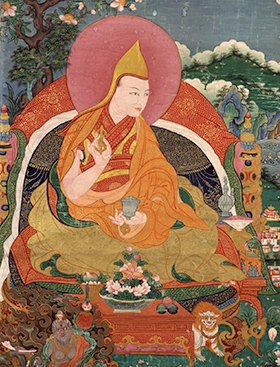
The Third Dalai Lama, Sonam Gyatso (1543–1588)
© Himalayan Art Resources
Moreover, during the same period the new Gelukpa school had founded a number of large monasteries in Ü province, namely Drepung, Sera and Ganden near Lhasa, the former imperial capital. The Gelukpa school, whose monasteries were supported by the laity and a number of nobles of Ü, had significant influence on the religious as well as on the political scene. In 1577–78 the conversion to Buddhism of Altan Khan, the leader of the Tumed Mongols, and all his subjects by Sonam Gyatso (1543–1588), the Abbot of Drepung (who received the title Dalai Lama from the Khan and was later recognized as the third to hold this title) was a spectacular success for the Gelukpa school. The secular government in Samdrubtse, however, viewed the event as a politico-religious alliance between the Gelukpa school and a foreign power. In fact, it was a strategic move in a struggle between two Buddhist religious schools – in this case the Gelukpa and the Karma Kagyupa – to secure the support of a patron without which neither could survive.
In 1589, the conflict was exacerbated when the Gelukpa recognized a child born that year to a Mongol family as the reincarnation of the Third Dalai Lama. The royal government took this as a clear indication of the Gelukpa school’s intentions to seek a foreign ally. After the child was installed in Ganden Phodrang at Drepung and enthroned as abbot, Mongol intervention in Gelukpa, and therefore in Tibetan, affairs increased. Moreover, the new Dalai Lama refused to bless the king of Tsang when they met. He came to be regarded as an expert in magic and was suspected of having performed a magic ritual against the king. However, he died shortly after at Drepung in 1616 at the age of twenty-eight, and the royal government forbade the search for his reincarnation.
In 1618, the Mongols and the Gelukpa monks began to attack the royal officials residing in Lhasa. This escalated into a general conflict between the government’s forces and the Gelukpa monks supported by the Mongols and several nobles of Ü. Fighting continued intermittently until 1621 and led to the establishment in the region of a great number of Mongols determined to protect Gelukpa interests. In 1621 near Lhasa, a battle that would have resulted in a great massacre on both sides was averted through the intervention of Panchen Lobzang Chögyen (1567–1662), the Abbot of Tashilunpo (who was later regarded as the First Panchen Lama).
The New Dalai Lama
It was against this background of turmoil that in 1617 a son was born to the noble Zahor family. From about the 14th century the family resided in the Taktse castle, the former stronghold of the Yarlung kings. The officials of Ganden Phodrang at Drepung had not renounced the search for the Dalai Lama’s reincarnation despite the ban by the Tsang king and the war between Ü and Tsang.
They had secretly discovered and selected three children whom they thought likely to be the Dalai Lama’s reincarnation. The child born to the famous Zahor family seemed the most convincing candidate. The family’s status was evidently a determining factor since two other schools, the Drukpa Kagyupa and the Karma Kagyupa, sought to claim the child as the reincarnation of one of their lamas since a lama of each school had also died in 1616. The family had resisted their solicitations despite the father’s friendly relations with the Drukpa Kagyupa school. In addition, the mother was connected to the Jonangpa school through her family, which was established at the castle of Nakartse. The names of both the mother and the son, Kunga Lhadze and Kunga Minjur, betray this link. We may therefore assume that the Jonangpa school hoped just as strongly to win the child over to their cause. This, however, was not to be the case, as we shall see.
The first six years of the Fifth Dalai Lama’s life resemble a novel. In 1618, his father, Düdül Rabten, was involved in a plot against the royal government, which brought the king’s wrath upon him. Around the same period, the Gelukpa, as already mentioned, secretly chose his son as the reincarnation of the Fourth Dalai Lama after the three candidates drew lots before the holy image of Radreng monastery. In the meantime, Panchen Lobzang Chögyen had convinced the king to lift the ban on the quest for the new incarnation.
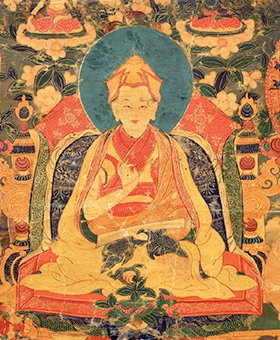
Panchen Lobzang Chögyen (1567–1662)
© Himalayan Art Resources
Nevertheless, the king ordered the Zahor family to leave their castle at Taktse. Düdül Rabten had attempted to escape to eastern Tibet but was prevented by royal envoys and brought to court at Samdrubtse where he remained under arrest until his death in 1626, without ever seeing his son again. His wife and son (aged three) were forced to remain in Dekyiling, then in Lhazong. The king suggested they come to live at court in Samdrubtse because of the insecurity caused by the war. But the mother, suspicious of the king’s real intentions, preferred to ignore his request and return to her family at the Nakartse castle. As soon as the ban on the quest for the reincarnation was lifted, Ganden Phodrang sent envoys accompanied by Mongol delegates to the king’s court, under the pretext of a diplomatic mission sent by Panchen Lobzang Chögyen, to request official recognition of the boy now living at Nakartse as the Fourth Dalai Lama’s reincarnation.
The child spent the first six years of his life in this castle and, in order to verify the authenticity of the reincarnation, he was subjected to the traditional “tests” bearing on his “memories" of his previous life. Among these “tests”, the best known is that of presenting the candidate with objects belonging to the previous incarnation along with other identical objects. If the child chooses the real objects he is proclaimed tulku, “reincarnate”. However, contrary to tradition, the boy belonging to the Zahor family had already been chosen by the drawing of lots before being submitted to the traditional tests.
One of the other two candidates, Drakpa Gyeltsen (1619–1656), was recognized as the reincarnation of another Gelukpa hierarch of Drepung. He was installed in the Zimkhang Gong or “Upper Chamber”, and was to become a redoubtable rival of the Fifth Dalai Lama, as we shall see.
The Fifth Dalai Lama retained bitter memories of his childhood during which the philosophical and religious precepts relative to the notion of reincarnation served political purposes. In his writings he would often recall with irony the political manipulations of his own school, which involved the Mongols in all its affairs. Thus he wrote in his autobiography, the Dukula:
Since there was a large Mongol army in the country and the Tibetan leaders were forced to yield much of their land to them, it became customary to recognize the sons of Mongol leaders as reincarnations. It was said that I too was one (even though I was not a Mongol)!¹
As for his success at passing the traditional “tests”, he is equally straightforward: “The official Tsawa Kachu of Ganden Phodrang showed me statues and rosaries (that belonged to the Fourth Dalai Lama and other people), but I was unable to distinguish between them! When he left the room I heard him tell the people outside that I had successfully passed the tests. Later, when he became my tutor, he would often admonish me and say: ‘You must work hard, since you were unable to recognize the objects!’”²
The child was brought to Ganden Phodrang, also known as Zimkhang Wog, the “Lower Chamber”. He was enthroned as the Fifth Dalai Lama and received the name of Lobzang Gyatso from Panchen Lobzang Chögyen, who became one of his spiritual masters. As soon as he was installed, the Mongols wanted him to go to Kokonor. His entourage considered him too young to undertake such a journey, but it soon became obvious that if they refused, the Mongols would take him by force. With the king’s permission, the officials of Ganden Phodrang therefore secretly transferred him to Rigo, in the south. This episode clearly shows that the alliance between the Gelukpa and the Mongols supported by the nobles of Ü was not without difficulties. The Fifth Dalai Lama was forced to remain in hiding in Rigo for a year. During that time he began to learn how to read and write.
From the age of six years, until he was twenty-four, his studies were devoted to traditional subjects such as Buddhist philosophy, Sanskrit and poetry. He developed a keen interest in Buddhist philosophy, the focus of study for the Gelukpa school, and was later to write a number of treatises on the subject. At the same time, he also had to perform his duty as abbot of Drepung monastery whose throne he occupied. In 1633, he met Konchok Lhundrub (1561–1637), a master of the Nyingmapa school, whose teachings were not always recognized by the Gelukpa school. This meeting was to be a turning point in his life: he received teachings and initiations into certain mystical practices and tantric rituals of which he hitherto had no knowledge. The young hierarch realized that his philosophical training at the monastery alone was not sufficient to attain spiritual enlightenment.
In the meantime, the “Upper Chamber” reincarnation, Drakpa Gyeltsen, had won fame in both Tibet and Mongolia as a brilliant scholar and spiritually accomplished person. This aroused envy in the Dalai Lama’s entourage even though Drakpa Gyeltsen had always proclaimed himself a disciple of the Fifth Dalai Lama. This situation was to have an unsettling effect on the harmony within the monastery.
Through the diplomacy of Panchen Lobzang Chögyen, the king and his government had ceased hostilities against the Gelukpa from the moment of the Fifth Dalai Lama’s enthronement. The Gelukpa community of Tsang, however, felt threatened by the establishment of a Karma Kagyupa monastery near Tashilunpo. Because of this, Mongol intervention on the Tibetan political scene was again to endanger the precarious balance of Tibetan politics.
The Mongols Intervene
Sonam Chöphel (1595–1657), the treasurer of Ganden Phodrang, was the prime architect of the Gelukpa school’s rise to political power. Later he received the title of Zhelngo, “the Leader”, which we will use hereafter when referring to him. He sought the support of the Jungar from western Mongolia and inspired them with a military stratagem that consisted of successively attacking the other Mongol tribes sympathetic to the king of Tsang, then the south-eastern Tibetans of Kham – who were also partisans of the royal government – and finally, the king and his entourage in Tsang, giving rise to Gelukpa political and religious supremacy.
The Jungar had been actively supporting the Gelukpa school in their own country. In 1636, one of their leaders, Gushri Khan of the Khoshut tribe, decided to attack the Mongol tribe of Chogthur, an ally of the king of Tsang. Originally from the Khalkha tribe, Chogthur’s tribe had been expelled from central Mongolia in 1634 and had set up their main camp in the Kokonor region in Amdo, in north-eastern Tibet. In 1637, after having defeated Chogthur and his 40,000 men in Kokonor, Gushri Khan, too, chose to make his camp in this territory of Tibetan nomads and soon became the sole leader of the Mongols in the region. He and several of his men travelled to central Tibet that year disguised as pilgrims. He was received in audience and it was at this time that the Fifth Dalai Lama bestowed on him the name of Tenzin Chögyel before the holy image of the Buddha in the Jokhang temple in Lhasa for having defended Gelukpa interests in the Kokonor region. The meeting was to have far-reaching historical consequences. As soon as he returned to the Kokonor region, the Mongol chief began to prepare his campaign against Donyö, king of Beri, in the province of Kham in south-eastern Tibet. Donyö was an ally of the king of Tsang, and, moreover, a Bön practitioner, which made him a staunch enemy of the Mongols who had just recently converted to Buddhism. In 1641, after a year of fighting, Gushri Khan defeated the king of Beri. His prestige as a warrior was now unequalled as much among Tibetans as among Mongols.
During the campaign against Beri, the Fifth Dalai Lama and the Zhelngo discussed the question of whether Gushri Khan and his men should return to Kokonor. They decided to send an emissary to Kham to contact the Mongol chief. In the presence of both the Dalai Lama and the emissary, the Zhelngo pretended to agree with the Dalai Lama that Gushri Khan should return to Kokonor after his campaign in south-eastern Tibet. However, just as the emissary was about to leave, the Zhelngo ordered him to tell Gushri Khan to lead his army against Tsang.
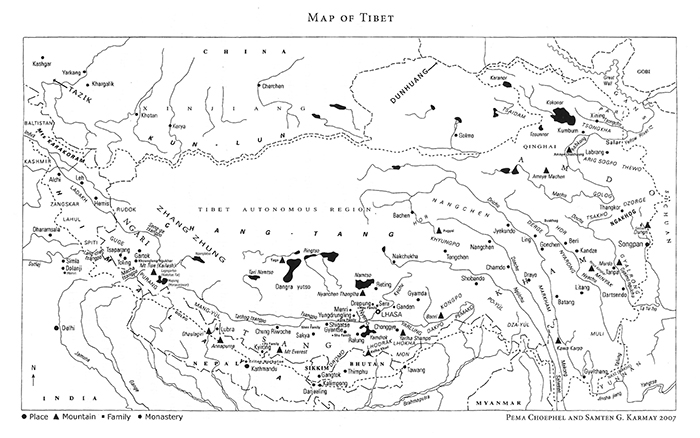
From The Illusive Play: The Autobiography of the Fifth Dalai Lama. by Samten G. Karmay, Serindia Publications, p. X
© Pema Choephel and Samten G. Karmay 2007
At the beginning of 1642, during the annual festival of the Great Prayer in Lhasa, presided over by the Fifth Dalai Lama, news of Gushri Khan’s victory in south-eastern Tibet and his army’s advance against Tsang reached the city. The news greatly surprised the Dalai Lama and the Zhelngo finally told him the truth: that in fact he himself had issued this order in the Dalai Lama’s name! Shortly after, Gushri Khan’s army confronted the king’s troops. It was to be a long and bloody war. After many months of battle, the king’s troops finally withdrew behind the walls of their stronghold at Samdrubtse. The Mongol troops, who had the advantage in open battle on the plain, now had to wait for the provisions of the king’s army to run out. The Zhelngo, more and more concerned over the course the events were taking, requested the Dalai Lama to go to Tsang as mediator. The Dalai Lama then displayed his true political stature by saying:
I have told you many times that I do not like this kind of thing (i.e., war). But you never listened to me. Now all know that the partisans of Ganden Phodrang have rebelled and that our man, Tardongpa, leads the Mongol army. Can there be any hope of mediation at present? The king and his entourage, being wise, might respond favourably to my approach. But the Mongols will never leave now. For my part, I am determined not to remain under the king’s rule.³
The Fifth Dalai Lama: Sovereign of Tibet
Towards the end of 1642, having resisted the Mongols for almost a year, the king and his two ministers finally surrendered. The Zhelngo and Gushri Khan then invited the Dalai Lama to Samdrubtse. Gushri Khan and the Zhelngo went to greet the hierarch and his entourage in Thobgyel. The next day he was received by a long procession consisting of the local population headed by six hundred horsemen. The Dalai Lama was then enthroned as King of Tibet at Samdrubtse and Gushri Khan offered him his conquests of central and eastern Tibet as a gift. The year 1642 was a crucial year and marked a turning point in Tibetan history because, for the first time, a Dalai Lama, previously merely the abbot of a monastery and leader of one religious school among several others, became the head of the country. The consequences of his rise to power were to be tremendous.
Although he had firmly established his power in central Tibet, the Dalai Lama still had to face various military conflicts in other regions, especially in Kongpo and the south, to which the leader of the Karma Kagyupa school had escaped and where the population, who for the most part belonged to this school, was determined to resist. In the following years, the Fifth Dalai Lama travelled extensively in order to ease the situation. During the same period, the Zhelngo took on the function of Desi, “regent”, and became responsible for governmental affairs, while Gushri Khan, who never claimed a political position, retained his role as the defender of the new government, always ready to intervene with his army if the need arose. The Fifth Dalai Lama continued to address him as “king” since he was the king of the Mongols of Kokonor (though he resided at Gongkar, about one hundred kilometres from Lhasa) and not “King of Tibet” as has often been falsely claimed.
The political structure of the new state began to take shape. The Dalai Lama was head of state. He was therefore placed above the chöyön structure, the “patron-preceptor” relationship. The Desi assumed the role of preceptor and Gushri Khan that of patron even though he was not really considered a foreigner since he had established himself in the Tibetan region of Kokonor and had placed himself entirely at the service of the Dalai Lama.
Ganden Phodrang, situated as it was within the monastic complex of Drepung, no longer befitted the purposes of the new state, since Drepung could not be considered the political capital of Tibet. This was equally true of Gonkar castle, Gushri Khan’s residence. Since the political situation in Kongpo – and even more so in southern Tibet – remained tense, the construction of a reliable stronghold that would also serve as the new seat of government was deemed necessary. Konchok Chöphel (d. 1646), who was a tutor of the Fifth Dalai Lama and, at the time, occupied the throne of Tsongkhapa (founder of the Gelukpa school), suggested Marpori, the Red Hill, as an ideal site, as it was situated between the monasteries of Drepung and Sera and the city of Lhasa. The construction of the Potala began in 1645 and its eastern section, Phodrang Karpo, the “White Palace”, was completed in 1649. That same year, the Fifth Dalai Lama and his government were installed there.
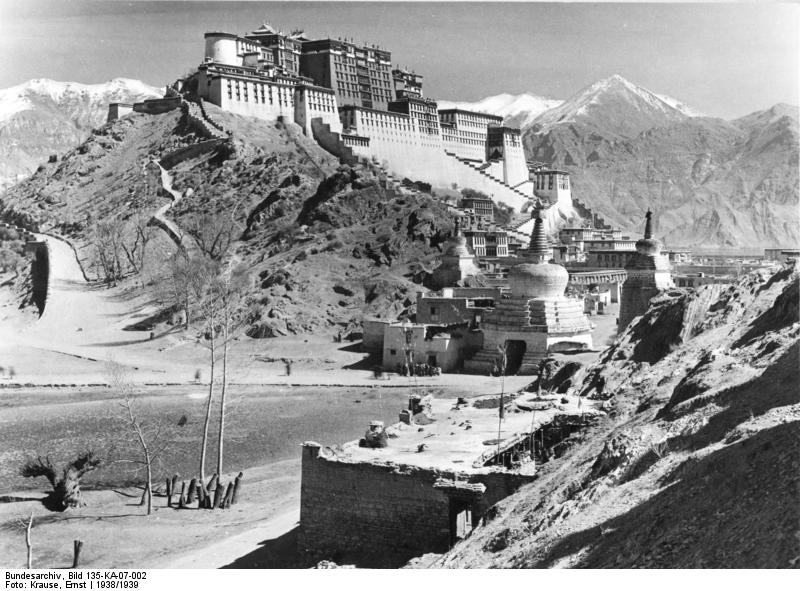
Ernst Schäfer Expedition to Tibet, Potala (1938)
Photographer: Krause, Ernst / Licence CC-BY-SA 3.0
© Bundesarchiv: Bild 135-KA-07-002
Shortly after moving to the Potala, the Fifth Dalai Lama had to deal with political issues beyond Tibet, especially concerning relations with the Manchu empire, relations that were to have great consequence on the future of Tibet.
The Journey to Beijing
The Manchus had recently emerged as a new power in the east. They had conquered China and established their capital in Beijing. Mongolia represented a serious threat for the new empire. Fearing Mongol attacks, the Manchus desperately needed peace to be maintained, and here the Dalai Lama played an essential role. He had considerable religious and political influence in Mongolia, whose population had for the most part converted to the Gelukpa school of Buddhism, and in the Kokonor region.
After having received several invitations from the Manchu Emperor Shunzi to make a state visit to Beijing, the Dalai Lama finally accepted in 1652. He set out with an entourage of three thousand men, and the journey took nine months. When the Dalai Lama reached the Sino-Tibetan border in Amdo, he sent a message asking the Emperor to meet him at the border. This request provoked divergent reactions between the Manchu and Chinese officials of the imperial court. While the Manchus were willing to comply, the Chinese officials were not. Finally, the Tibetan and imperial officials reached a compromise to solve this problem of protocol. Since the Dalai Lama was a guest he would travel into Chinese territory, to Kirutaka where the Manchu government had erected a residence to accommodate him. Because of the poor harvest and an epidemic in China that year, it was agreed that the Dalai Lama would proceed from there with only three hundred men. The Emperor would await the Dalai Lama at Ridak Khoto, a place where he often went hunting.
As soon as the Dalai Lama entered Chinese territory, the Emperor sent emissaries, mostly members of the imperial family, to greet him all along his way. The Fifth Dalai Lama himself recounts in his writings his meeting with the Emperor and all the intricacies of protocol surrounding it:
The 16th of the twelfth month, I met the king. We entered a place surrounded by walls, and the seven royal emblems, symbols of the Universal King, unravelled before us. They were all impressive and comparable to the glory of Indra. When the throne became visible, those near me dismounted and continued on foot. I proceeded some forty metres further and then dismounted, while the king also descended from his throne and walked approximately ten metres towards me. He took my hands and welcomed me with interpreters. He then returned to his throne whose height reached a man’s hip. On the throne stood a low stool on which he sat. A metre away another throne had been erected for me. It was slightly lower (due to the small stool on the other). When tea was served, the king asked me to drink first. I replied that this would not be proper. So he suggested we drink at the same time. He showed much respect (to his guest).⁴
During his sojourn in Beijing, the Dalai Lama resided in the Yellow Palace specially built near Beijing for the state visit. His stay there lasted two months and was marked by two grand imperial receptions given in his honour and by various other official receptions that the two heads of state gave one another. He left Beijing at the beginning of 1653 for Kirutaka where he remained three months to prepare his return journey to Lhasa.
Just a few days before his departure for Tibet, a gold seal and a gold plaque engraved with a decree were hastily sent to him from Beijing. The imperial functionaries had not dared present the seal to the Dalai Lama in front of the Emperor while the Dalai Lama was officially visiting Beijing as head of state of a foreign country. Since the seal was given to the Dalai Lama with no particular form of protocol, he attached little importance to it. He simply remarks in his autobiography that the Tibetan translation of the title engraved on the seal was very poor.⁵ The seal, however, is currently exploited by the Chinese authorities for propaganda purposes to justify their policy towards Tibet.
Politics and Intrigues
For having successfully achieved this long and hazardous journey, the Dalai Lama was welcomed with great pomp by the whole population of Lhasa and representatives of all the other regions of Tibet, who organized a triumphant march in his honour. The number of gifts he received from the Amdo Tibetans, Mongols, Manchus and Chinese for the Buddhist teachings he had dispensed throughout his journey was impressive: thousands of horses, camels and precious objects.
Upon his return, the Dalai Lama was again faced with internal political problems that put his abilities as a negotiator to the test. He took the opportunity while visiting Samdrubtse in 1654 to resolve a politico-religious problem that had been hindering his rule for a long time. In 1621, the king of Tsang entrusted the organization of the annual festival of the Great Prayer in Lhasa to Panchen Lobzang Chögyen and his monastery, Tashilunpo, in order to thank him for his mediation between the royal forces and the Gelukpa monks of Lhasa, supported by the Mongols. The Desi, always primarily concerned with the interests of Drepung, reclaimed the duty of organizing the yearly festival for his own monastery, as had always been the case prior to 1621. In 1632, Tashilunpo was forced to return this function to Drepung, but relations between Panchen Lobzang Chögyen and the Desi remained strained. They were finally reconciled by the Dalai Lama when he visited Samdrubtse in 1654.
Furthermore, in 1674, the Dalai Lama received the Karmapa hierarch at the Potala with all the respect due to his rank, a reconciliation welcomed by both parties after the many conflicts and misunderstandings that had lasted from 1612 to 1642. But he was not so lenient towards the other schools. For instance, the Jonangpa school, which had hoped to obtain him, when he was a child, as one of their own reincarnations, did not survive in Central Tibet.* As for the Bönpo monasteries, several were forced to convert to the Gelukpa tradition.** The new government’s attitude, however, was in fact determined by political rather than religious considerations.
Two other incidents during the rule of the Fifth Dalai Lama provide an interesting insight into the court intrigues at the time, and more specifically into the relations between religion and politics and their effects, which can still be felt today.
In 1656, Drakpa Gyeltsen, the reincarnation who was installed in the “Upper Chamber” at Drepung, died. It should be recalled that he had been one of the candidates for the reincarnation of the Fourth Dalai Lama. As a result, he was always seen as a rival of the Fifth Dalai Lama even though he invariably proclaimed himself a disciple of the latter. He came to be despised by a number of officials and especially the Desi. The circumstances of his death, whether natural or not, were contested and part of the Gelukpa school believed that the official Norbu, acting under the Desi’s orders, had assassinated him. Whatever the truth, the search for his reincarnation was banned, which suggests that the affair must have been quite serious indeed. In 1658, the actual building of the “Upper Chamber” was destroyed and the stupa containing the remains of the Lama was supposedly thrown into the Kyichu river. It was then believed that the spirit of Drakpa Gyeltsen had returned and he was subsequently deified as a sort of “protector of the Buddhist religion”. This marked the beginning of his cult as a protective deity, later named Dorje Shukden by the fundamentalist faction of the Gelukpa. This cult however has always been a controversial issue and was recently banned by the Fourteenth Dalai Lama in India. The mystery surrounding Drakpa Gyeltsen’s death thus remains one of the most enigmatic aspects of the Fifth Dalai Lama’s rule. Indeed, in 1659, the official Norbu, who had settled at Gekha Sapa, a residence belonging to Drakpa Gyeltsen’s family, fomented a rebellion against the Fifth Dalai Lama’s government. He was suspected of conspiring with the Drukpa Kagyupa power in Bhutan, a great enemy of the Gelukpa. The conflict was resolved through the intervention of Panchen Lobzang Chögyen.
In 1662, Panchen Lobzang Chögyen died at the age of 93. The Fifth Dalai Lama immediately decided to establish the system of his reincarnation. He ordered the monks of the great monasteries to recite a prayer he composed himself, requesting the master “to return”. The reincarnation was discovered in 1667 in the Dru family, one of the five great lineages of the Bön tradition, probably in a gesture of reconciliation with this particular religious tradition, which, in a 1679 edict, the Fifth Dalai Lama recognized as one of the official religions in Tibet. The consequences of the official establishment of this system of reincarnation have not always been favourable to the political unity of the Gelukpa, and therefore to Tibetan unity as a whole. The lamas of this series of reincarnation later became known as the Panchen Lama and were often considered spiritually eminent, but on the political level their relations with the Dalai Lamas were often difficult despite the spiritual master-disciple relationship they were supposed to maintain with one another. The Panchen Lama was often the object of manipulation against the Dalai Lama, first by the Manchus, then the British in India, and finally, by both the Kuomintang and communist Chinese.
Head of a Powerful State
The Fifth Dalai Lama’s ever increasing diplomatic activities, often dictated by the circumstances of the day, covered not only the whole of the Tibetan world – Mongolia, Ladakh and Bhutan – but also extended as far as China. The danger of conflicts breaking out was ever present, and the Dalai Lama not only had to ensure the survival of his own government but also act as a mediator between the various rising political powers that were always threatening to disrupt the established order.
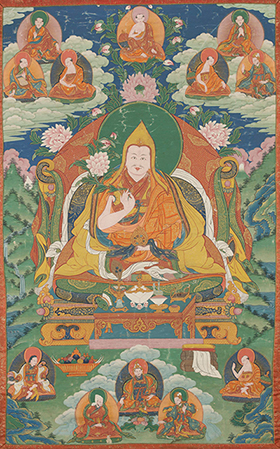
The Fifth Dalai Lama
© Himalayan Art Resources
Under the Fifth Dalai Lama’s rule, as under the ancient Tibetan empire, Kokonor in Amdo became one of the most strategically important regions. The hierarch was quick to realize this as he travelled through the region, first in 1652 and then in 1653. Eight of Gushri Khan’s ten sons with their respective tribes had settled there in 1638 after their arrival from western Mongolia. The brothers were constantly engaged in territorial quarrels. In 1656 and in 1659, the Dalai Lama sent a number of governors to Kokonor. One of them divided the local populations in accordance with different territories and called them the right and left “horns” following the example of central Tibet at the time of the imperial period. The Mongols of this region were later completely Tibetanized but continued to enjoy considerable prestige among the Tibetans as descendants of Gushri Khan. They clearly played a significant role in the expansion of the Gelukpa school in Amdo. On several occasions in 1667, 1674 and 1675, at the request of the Manchu Emperor, the Dalai Lama played an important diplomatic role as a mediator in the military conflicts between Manchus and Mongols, and between the Manchu Emperor and a minister of his predecessor. These mediations clearly show the importance of the Dalai Lama’s political and religious influence over the Mongol, Manchu, Chinese and Tibetan populations.
Two other important diplomatic events also marked his reign. Under the rule of the king of Tsang, relations between Tibet and Bhutan, then simply designated as Mön or Lho Mön, entered a difficult phase. Again the issue concerned a reincarnation. There were two candidates for the reincarnation of Pema Karpo (1527–1592), the great scholar of the Drukpa Kagyupa school. Around 1615, the candidacy of Ngawang Namgyel (1594–1651) for the reincarnation was supported by his own family of Ralung, the seat of the school, while the other candidate, Pagsam Wangpo (1593–1641), a cousin of the Fifth Dalai Lama, was supported by the king of Tsang. Ngawang Namgyel had defied the king’s order to bring to the court the holy bone image of Khasarpani, obtained from the cremation of Tsangpa Gyare (1161–1211), founder of the Drukpa Kagyupa school. It was kept by the family of Ralung. Indeed, this would have meant that Ngawang Namgyel renounced his claim as the reincarnation of Pema Karpo. His refusal angered the king and he was finally forced to flee to Mön taking the relic with him. There he established his own politico-religious power and administration over a great part of the local population, thus unifying what has become known as Bhutan. The constitution of a Drukpa Kagyupa state headed by a religious and political enemy did not greatly appeal to the Lhasa government. Following territorial skirmishes, in 1647 the Desi decided to launch a military campaign against Bhutan; however, this ended in a humiliating defeat for the Gelukpa and their Mongol allies.
On the other hand, the campaign against Ladakh in 1679 was crowned with success and the regions of Ngari in Western Tibet, which the kings of Ladakh had annexed, were taken back. Thus, under the Fifth Dalai Lama, Tibet, from Ngari in the west to Dartsedo, Kham, in the south-east and to Kokonor in Amdo in the north-east was reunified for the first time since the collapse of the Tibetan empire in the 9th century A.D.
Writer and Mystic
Over and above his political achievements, the Fifth Dalai Lama was far more concerned with spiritual matters. Writing was his favourite occupation and he never interrupted it whatever the circumstances, whether he was travelling or in retreat. His works fill twenty-seven volumes. Besides writing a number of treatises on various subjects, he also related his visionary experiences, which he kept secret because of his own religious school’s disapproval of such matters. He wrote in a very free and personal style that allowed him to express his own feelings, which were at once both frank and ironic. His autobiography is characterized by his spontaneity, his sarcasm and his humorous remarks concerning his own status as a reincarnation and the fundamentalist attitude of his own school, the Gelukpa. Very often, unlike other traditional Gelukpa authors, he gives his own independent interpretation, which he never attempts to impose. Concerning two of his treatises, he writes: “When I finished the Jampel Zhelung, I had to leave the ranks of the Gelukpa. Today, having completed the Rigzin Zhelung, I think I will probably have to leave the Nyingmapa ranks as well!”⁶ In fact, both texts later came to be considered masterpieces and works of reference by all the Tibetan Buddhist schools. His approach to the various religious and philosophical traditions was indeed universal, which helped his rule, which in turn was marked by great tolerance towards the other schools. The Bönpo, followers of the Bön religion, the only non-Buddhist religion of Tibet, were, after certain difficulties at the beginning of his rule, respected both at the doctrinal and political levels.
The Fifth Dalai Lama continued to write until a few months before his death in 1682, at the age of 65. His exceptional personality, both complex and engaging, made him undeniably one of the most important figures in Tibetan history. His legacy was to have a profound effect on almost every aspect of the country’s culture, notably architecture, poetry, historiography, civil administration, painting and, of course, philosophy and Buddhist meditation. He was both a remarkable statesman and Buddhist monk, thus embodying the Buddhist ideal of a “great being”. Tibetan tradition still venerates him as the “Great Fifth”. His strict monastic discipline concealed yet another facet of his spiritual life: his great interest for tantric, more or less magical rituals, and, above all, his inclination for mystic meditation, which provided him with a series of visionary experiences throughout his life. These he revealed only in his writings, which remained little known in his time and which show his never ceasing concern for the welfare of his country and people. ■
Bibliographical sources
Ngag-dbang blo-bzang rgya-mtsho, the Fifth Dalai Lama
rJe btsun thams cad mkhyen pa bsod nams rgya mtsho’i rnam thar dngos grub rgya mtsho’i shing rta, The Collected Works of the Vth Dalai Lama, Gangtok: Sikkim Research Institute of Tibetology, 1991, Vol. 8 (Nya), 31-245.
Ngag-dbang blo-bzang rgya-mtsho, the Fifth Dalai Lama
’Jig rten dbang phyug thams cad mkhyen pa yon tan rgya mtsho dpal bzang po’i rnam par thar pa nor bu’i ’pheng ba, ditto, 247-349.
Ngag-dbang blo-bzang rgya-mtsho, the Fifth Dalai Lama
Khyab bdag ’khor lo’i dbang phyug dpal ’byor lhub grub kyi rnam thar skal bzang dad pa’i shing rta, ditto, 610-696.
Ngag-dbang blo-bzang rgya-mtsho, the Fifth Dalai Lama Byang bdag rig ’dzin ngag gi dbang po’i rnam thar ngo mtshar bkod pa rgya mtsho, ditto, 687-823.
Ngag-dbang blo-bzang rgya-mtsho, the Fifth Dalai Lama
Dukula, Za hor gyi ban de ngag dbang blo bzang rgya mtsho’i ’di snang ’khrul ba’i rol rtsed rtogs brjod kyi tshul du bkod pa dukula’i gos bzang, (Lhasa): Bod-ljongs midmangs dpe-skrun khang, Vols. I-III, 1989.
Footnotes
¹ Dukula, Vol I, 48.
² Dukula, Vol I, 55.
³ Dukula, Vol I, 204.
⁴ Dukula, Vol I, 393.
⁵ Dukula, Vol I, 415–16.
⁶ Dukula, Vol II, 380.
* This sentence is revised by me, the author Samten Karmay. (Feb. 24, 2016)
** The conversion of the monasteries was actually carried out by Desi Sangye Gyatso (1658-1705) in 1686 in Khyungpo, Kham, cf. Samten Karmay, The Arrow and the Spindle, Vol.II, 2005, p.164. (Feb. 24, 2016)



